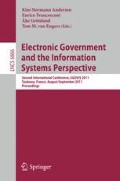Abstract
Pseudonymization is sometimes used as a light-weight alternative to fully cryptographic solutions, when information from different data sources needs to be linked in a privacy-preserving manner. In this paper, we review several previously proposed pseudonymization techniques, point out their cryptographic and design flaws. As a solution, we have developed a simple pseudonymization framework based on X-Road, a unified database access layer serving as the basis for most eGovernment services developed in Estonia. Our solution has been fully implemented and benchmarking results together with the security analysis are presented to conclude the paper.
Access this chapter
Tax calculation will be finalised at checkout
Purchases are for personal use only
Preview
Unable to display preview. Download preview PDF.
References
Agrawal, R., Evfimievski, A., Srikant, R.: Information sharing across private databases. In: Proceedings of the 2003 ACM SIGMOD International Conference on Management of Data, SIGMOD 2003, pp. 86–97. ACM, New York (2003)
Ansper, A., Buldas, A., Freudenthal, M., Willemson, J.: Scalable and eficient PKI for inter-organizational communication. In: Proceedings of the 19th Annual Computer Security Applications Conference, pp. 308–318. IEEE, Los Alamitos (2003)
Bellare, M., Rogaway, P.: Random oracles are practical: a paradigm for designing efficient protocols. In: Proceedings of the 1st ACM Conference on Computer and Communications Security, CCS 1993, pp. 62–73. ACM, New York (1993)
Ben-David, A., Nisan, N., Pinkas, B.: FairplayMP: a system for secure multi-party computation. In: CCS 2008: Proceedings of the 15th ACM conference on Computer and communications security, pp. 257–266. ACM, New York (2008)
Bogdanov, D., Laur, S., Willemson, J.: Sharemind: A framework for fast privacy-preserving computations. In: Jajodia, S., Lopez, J. (eds.) ESORICS 2008. LNCS, vol. 5283, pp. 192–206. Springer, Heidelberg (2008)
Bogetoft, P., Christensen, D.L., Damgård, I., Geisler, M., Jakobsen, T.P., Krøigaard, M., Nielsen, J.D., Nielsen, J.B., Nielsen, K., Pagter, J., Schwartzbach, M.I., Toft, T.: Secure multiparty computation goes live. In: Dingledine, R., Golle, P. (eds.) FC 2009. LNCS, vol. 5628, pp. 325–343. Springer, Heidelberg (2009)
Canetti, R., Goldreich, O., Halevi, S.: The random oracle methodology, revisited. J. ACM 51, 557–594 (2004)
Chaum, D.: Security without identification: Transaction systems to make big brother obsolete. Commun. ACM 28(10), 1030–1044 (1985)
Galindo, D., Verheul, E.R.: Microdata sharing via pseudonymization. In: Work Session on Statistical Data Confidentiality, Manchester, December 17-19, 2007, pp. 24–32. Eurostat (2009)
Galindo, D., Verheul, E.R.: Pseudonymized Data Sharing. In: Privacy and Anonymity in Information Management Systems: New Techniques for New Practical Problems. Advanced Information and Knowledge Processing, pp. 157–179. Springer, Heidelberg (2010)
Gentry, C.: Fully homomorphic encryption using ideal lattices. In: Proceedings of the 41st Annual ACM Symposium on Theory of Computing, STOC 2009, pp. 169–178. ACM, New York (2009)
Kalja, A.: System integration process of government information systems. In: Kocaoglu, D., Anderson, T., Piscataway, N. (eds.) Proceedings of PICMET 2003: Portland International Conference on Management of Engineering and Technology (2003)
Kalja, A., Reitsakas, A., Saard, N.: eGovernment in Estonia: best practices. In: Anderson, T.R., Daim, T.U., Kocaoglu, D.F., Piscataway, N. (eds.) Technology Management: A Unifying Discipline for Melting the Boundaries, pp. 500–506 (2005)
Lo Iacono, L.: Multi-centric universal pseudonymisation for secondary use of the EHR. Studies in Health Technology and Informatics 126, 239–247 (2007)
Malkhi, D., Nisan, N., Pinkas, B., Sella, Y.: Fairplay—a secure two-party computation system. In: SSYM 2004: Proceedings of the 13th Conference on USENIX Security Symposium, pp. 287–302. USENIX Association, Berkeley (2004)
Narayanan, A., Shmatikov, V.: Robust de-anonymization of large sparse datasets. In: IEEE Symposium on Security and Privacy, pp. 111–125 (2008)
Neubauer, T., Heurix, J.: A methodology for the pseudonymization of medical data. International Journal of Medical Informatics, 1–15 (November 2010) (in print)
Neubauer, T., Kolb, M.: Technologies for the Pseudonymization of Medical Data: A Legal Evaluation. In: Fourth International Conference on Systems, pp. 7–12. IEEE, Los Alamitos (2009)
Pommerening, K., Reng, M.: Secondary use of the EHR via pseudonymisation. Studies in Health Technology and Informatics 103, 441–446 (2004)
Riedl, B., Grascher, V., Fenz, S., Neubauer, T.: Pseudonymization for improving the Privacy in E-Health Applications. In: Proceedings of the 41st Annual Hawaii International Conference on System Sciences (HICSS 2008), pp. 255–264. IEEE, Los Alamitos (January 2008)
Riedl, B., Grascher, V., Neubauer, T.: A Secure e-Health Architecture based on the Appliance of Pseudonymization. Journal of Software 3(2), 23–32 (2008)
Song, J., Poovendran, R., Lee, J., Iwata, T.: The AES-CMAC Algorithm. IETF RFC 4493 (June 2006), http://www.ietf.org/rfc/rfc4493.txt
Willemson, J., Ansper, A.: A Secure and Scalable Infrastructure for Inter-Organizational Data Exchange and eGovernment Applications. In: 2008 Third International Conference on Availability, Reliability and Security, pp. 572–577. IEEE, Los Alamitos (2008)
Author information
Authors and Affiliations
Editor information
Editors and Affiliations
Rights and permissions
Copyright information
© 2011 Springer-Verlag Berlin Heidelberg
About this paper
Cite this paper
Willemson, J. (2011). Pseudonymization Service for X-Road eGovernment Data Exchange Layer. In: Andersen, K.N., Francesconi, E., Grönlund, Å., van Engers, T.M. (eds) Electronic Government and the Information Systems Perspective. EGOVIS 2011. Lecture Notes in Computer Science, vol 6866. Springer, Berlin, Heidelberg. https://doi.org/10.1007/978-3-642-22961-9_11
Download citation
DOI: https://doi.org/10.1007/978-3-642-22961-9_11
Publisher Name: Springer, Berlin, Heidelberg
Print ISBN: 978-3-642-22960-2
Online ISBN: 978-3-642-22961-9
eBook Packages: Computer ScienceComputer Science (R0)

